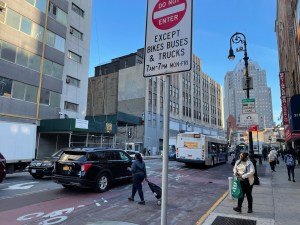Eyes on the Street: Jay Street Busway is a Work In Progress
First of five planned busways is missing paint and stops — and the placard abusers haven't gone anywhere.

The highly touted Jay Street Busway has some catching up to do if it wants to join the major leagues like its car-restricting cousin on 14th Street in Manhattan, Streetsblog learned in a review of the first day of operations on Monday.
The busway still lacks the iconic red paint that lets drivers know that the road belongs only to buses, as well as paint indicating bus stops. The Department of Transportation has put up signs indicating the new traffic rules: From 7 a.m. to 7 p.m. on weekdays, the only vehicles that may enter at Livingston or at Tillary are buses and trucks. Local traffic on Jay only may access the street from from Willoughby Street, MetroTech Center or Johnson Street, and then must turn off the street at the first available opportunity.
Still, a lack of human enforcement — no one reminded drivers entering at Livingston or at Tillary that they could not use Jay as a through street — is hampering the busway’s full operation and reflects a dramatic change from the army of enforcement officers who greeted the debut of the 14th Street busway last year. So many car drivers treated the new Jay Street like the old Jay Street that some bus riders said that they didn’t notice any change.
Oh, and some parking is still allowed on the street.

“So far, it seems to be okay,” a B54 driver told Streetsblog while he drove his route. “It’s still early in the game, and today’s the first day, but what we really need is enforcement from DOT, which we have not had. They used to put yellow lines to indicate bus stops, that would be effective to introduce now. That’s how a lot of problems happen: people mistakenly thinking it’s not a bus stop when it is. It comes down to one thing, and that’s enforcement from the DOT; otherwise, people get away with it and that absolutely makes our job a lot harder.”
The Downtown Brooklyn busway, the first of five busways and other dedicated bus lanes, totaling 20 miles, that Mayor de Blasio promised back in June, runs from Livingston to Tillary Street. According to the Tri-State Transportation Campaign, the busway, while slight, is mighty: The organization’s analysis showed that the .4-mile car-free strip could help 47,000 daily bus riders get where they’re going faster than they once did on buses that moved at less than five miles an hour during rush hour.
“My ride was the same,” said Roy M., a passenger on the B57. “I feel like they should emphasize it more, to say that it’s only buses and no cars. I feel they don’t care much about doing more for New York’s buses.”

But if some drivers were still trying to have their way on Jay Street, by double parking and blocking buses, fewer private cars drove on the block, which bus riders said they appreciated.
“It was an easier and faster ride; I think it made a difference,” B67 rider Gilly Simmons said of the new traffic arrangement.
The new design also hasn’t seemed to affect the local plague of placard abuse. The DOT said that the new traffic restrictions on the block would help tamp down on illegitimate placards and improper placard parking, which often extended into bike lanes and bus stops on Jay Street. So far, however, the placard class hasn’t yielded. Out of 28 cars parked on Jay between Fulton Street and Tillary Street, 25 had placards and and three had some kind of construction vest in place of a placard. But of the 25 cars with legitimate placards, only 10 were parked in spaces that were reserved for placard holders.
Time will tell whether the rest of the busway’s kinks will get worked out, although the DOT said in August that the street painting would most likely be done after the beginning of new traffic patterns. Transit advocates hailed the opening of the first busway since 14th Street, but still reminded the mayor that he had more to do, especially on projects such as the Main Street Busway in Flushing, which has stalled in the face of local opposition.
“The Jay Street busway will make a big difference in the lives of tens of thousands of Brooklyn riders who have long suffered some of the slowest service in the U.S.,” said Riders Alliance Senior Organizer Jolyse Race. “This new busway through the nation’s third largest business district is a historic win for transit equity as well as access to struggling retail businesses. The Riders Alliance is proud to applaud the mayor and the Department of Transportation for delivering for Brooklyn riders. We’re also eager to see Mayor de Blasio complete the remaining projects in his promised 20 miles of new, COVID-era emergency bus lanes and busways citywide.”
— with Adam Light and Gersh Kuntzman




